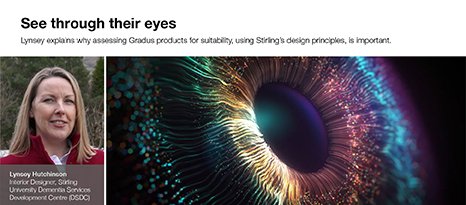In the second in our series of guest blogs about inclusive design for dementia, Lynsey Hutchinson, Senior Interior Designer at the Dementia Services Development Centre, University of Stirling, discusses the role of scientific research in dementia-friendly design for buildings.
As Senior Interior Designer at the Dementia Services Development Centre, it’s my job to consider dementia from the point of view of design. Dementia is a disease of the brain and it has a lot of effects, with no two people experiencing it the same way. However, it is vital that building designers always consider the needs of people with dementia when making their plans for care homes and similar buildings.
One critical aspect that needs to be considered is tonal contrast. This is because people with dementia often have trouble perceiving contrasts between surfaces, leading to trips and falls. For example, it is important that people with dementia can see where the floor ends and the wall begins, so there should be at least 30 points of light reflectance value (LRV) between these two surfaces.
On the other hand, a common issue that people who are living with dementia can have in a normal building is with falls caused by high stepping – or expecting a step where none is present, due to too much contrast between the floorcoverings. This is why floor coverings that are adjacent to each other should have no more than 8 LRV (light reflectance value) points between them, ensuring that the building user perceives one consistent floor and therefore doesn’t fall.
Another important consideration is circadian rhythm, or the natural, internal process whereby our bodies regulate sleeping and waking. For people with dementia, this can be affected by exposure to overly bright artificial lighting in the evening and lack of natural daylight during daytime hours, causing them to want to sleep during the day and then be awake at night. Well-considered lighting systems, window dressings, and barrier-free access to outside areas are therefore key when it comes to interior design for dementia.
We have been working alongside Gradus since 2014, and have evaluated and assessed their products to ensure that they are suitable for use in dementia-friendly environments such as care homes. We’re always delighted to form this kind of relationship with leading manufacturers, because it means that our research is used out there in the real world, not just in university papers. That makes all the difference.
Speak to us for expert advise about how to design for independant living and inclusive design, including dementia, on 0808 196 5640



